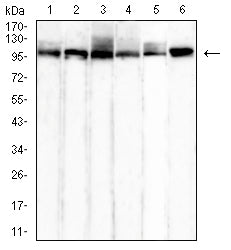
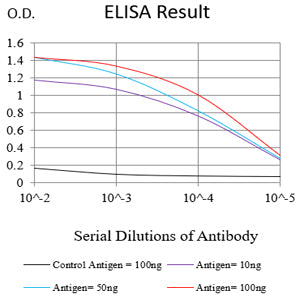


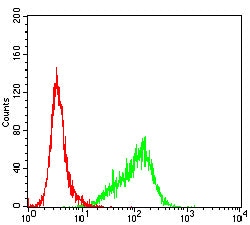
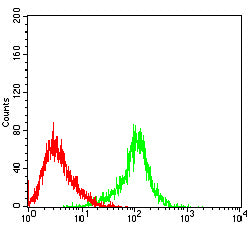
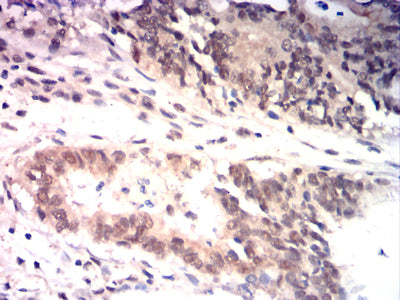
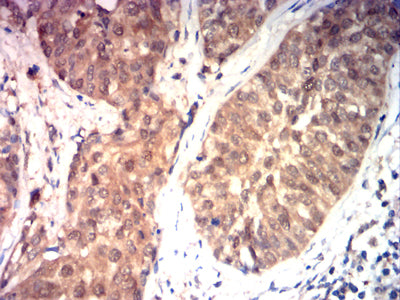
| WB | 1/500 - 1/2000 | Human, Monkey |
| IF | 咨询技术 | Human, Monkey |
| IHC | 1/200 - 1/1000 | Human, Monkey |
| ICC | 1/200 - 1/1000 | Human, Monkey |
| FCM | 1/200 - 1/400 | Human, Monkey |
| Elisa | 1/10000 | Human, Monkey |
| Aliases | RY; APG-2; HSPH2; hsp70; hsp70RY; HEL-S-5a; HS24/P52 |
| Entrez GeneID | 3308 |
| clone | 2E4F10B11 |
| WB Predicted band size | 94.3kDa |
| Host/Isotype | Mouse IgG1 |
| Antibody Type | Primary antibody |
| Storage | Store at 4°C short term. Aliquot and store at -20°C long term. Avoid freeze/thaw cycles. |
| Species Reactivity | Human, Monkey |
| Immunogen | Purified recombinant fragment of human HSP70 (AA: 642-841) expressed in mammalian. |
| Formulation | Purified antibody in PBS with 0.05% sodium azide |
+ +
以下是关于HSP70抗体的3篇代表性文献及其简要摘要:
---
1. **"HSP70 as a biomarker for cancer detection and therapeutic targeting"**
*Daugaard, M., et al. (2007). Cancer Letters.*
摘要:探讨HSP70在多种癌细胞中过表达的机制,提出其作为癌症诊断标志物的潜力,并综述HSP70抗体在肿瘤靶向治疗及免疫组化检测中的应用。
2. **"The role of molecular chaperones in protein aggregation diseases"**
*Morimoto, R.I., et al. (2008). Nature Reviews Molecular Cell Biology.*
摘要:分析HSP70等分子伴侣在阿尔茨海默病、帕金森病中的作用,强调通过HSP70抗体检测异常蛋白聚集体,为神经退行性疾病研究提供工具。
3. **"Antibody-based validation of stress-inducible HSP70 in human tissues"**
*Kampinga, H.H., et al. (2009). Cell Stress and Chaperones.*
摘要:比较多种HSP70抗体在Western blot、免疫荧光等实验中的特异性,提供标准化使用建议,验证HSP70在热休克或氧化应激模型中的表达变化。
---
这些文献覆盖了HSP70抗体在疾病机制研究、诊断工具开发及实验方法优化中的关键应用。如需扩展领域(如感染免疫或自身免疫病),可补充以下文献:
4. **"HSP70 autoantibodies in autoimmune diseases: Pathogenic or protective?"**
*Tukaj, S., Węgrzyn, G. (2020). Cell Stress and Chaperones.*
摘要:讨论HSP70自身抗体在系统性红斑狼疮、类风湿关节炎中的双重作用,评估其作为疾病活动度生物标志物的潜力。
---
建议通过PubMed或Web of Science检索具体研究方向的更新进展。
HSP70 antibodies are essential tools for studying the heat shock protein 70 (HSP70) family, a group of highly conserved molecular chaperones critical for protein homeostasis. HSP70 proteins, including isoforms like HSPA1A, HSPA8. and HSPA9. assist in folding nascent polypeptides, refolding misfolded proteins, and targeting irreparable proteins for degradation. They are upregulated under cellular stress (e.g., heat, oxidative damage, or infection) to protect cells from damage. Dysregulation of HSP70 is linked to cancer, neurodegenerative diseases (e.g., Alzheimer’s), and inflammatory conditions, making it a biomarker and therapeutic target.
HSP70 antibodies are widely used in research to detect protein expression, localization, and interactions via techniques like Western blot, immunohistochemistry (IHC), and immunoprecipitation. Monoclonal antibodies offer high specificity for particular isoforms, while polyclonal antibodies may detect broader epitopes but risk cross-reactivity. Commercial HSP70 antibodies are often validated across species (human, mouse, rat) due to the protein’s high sequence conservation.
However, challenges exist, such as distinguishing between stress-inducible HSP70 (e.g., HSPA1A) and constitutive isoforms (e.g., HSPA8), which share significant homology. Researchers must select antibodies validated for their specific experimental context. Additionally, HSP70’s role in cancer—both as a tumor suppressor and promoter—underscores the need for precise antibody characterization in therapeutic development. These antibodies also hold diagnostic potential, as elevated HSP70 levels in blood or tissues correlate with disease progression in certain cancers or neurodegenerative disorders.
×